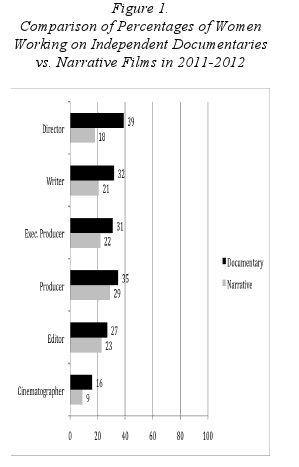Women are still struggling to break through a celluloid glass ceiling in the feature film business, but the documentary world has become a much more open to female directors, writers and cinematographers.

Women made up 39 percent of directors behind the documentaries screening at high-profile film festivals like Sundance and Tribeca in the United States between 2011 to 2012, according to a study released Tuesday by the Center for the Study of Women in Television and Film at San Diego State University.
That diversity is staggering considering that a mere 5 percent of the directors involved with the top 250 domestic grossing films of 2011 were women.
Between 2008 and 2009, women represented 28 percent of documentary directors at major film festivals.
For Martha Lauzen, the center's executive director and the author of the study, the greater diversity is a matter of dollars and cents — a luxury that comes from the lower cost of producing documentaries.
Also read: Celluloid Ceiling: Women Comprised Only 5% of Directors in 2011
"Traditionally, documentaries have been more welcoming of women and diversity in general because the barriers to entry are lower than they are in narrative features," Lauzen said.
Although the independent film world is more open to the concept of women like Lisa Cholodenko ("The Kids Are All Right," pictured below) and Nicole Holofcener ("Please Give") handling directing duties, female representation still lags behind the documentary industry. Of narrative features screened at major festivals, women represented 18 percent of directors between 2011 to 2012, compared to 15 percent between 2008 to 2009.

"That director role is traditionally the most male role," Lauzen said. "With narrative films, whether they are independently produced or produced by a studio, there is still that celluloid ceiling women have to overcome."
Lauzen said that female directors' success in documentary films has yet to lead to many deals to direct larger projects for big studios.
There have been some positive developments, however. Having women in positions of power has served to promote other female talent in what has historically been a male-dominated industry.
"Both in film and in television, when you have a woman in a position to hire others, she tends to hire women at a greater rate than a man does in the same position," Lauzen said. "I don't even think it’s necessarily conscious. People tend to hire other people who look like themselves or with whom they feel most comfortable."
This predilection to hire people of the same gender helps explain the better representation that women enjoyed across almost all major categories in the documentary field than in the narrative feature sector.
On the documentary front, women were best represented as directors (39 percent) followed by producers (35 percent), writers (32 percent), executive producers (31 percent), editors (27 percent) and cinematographers (16 percent).
For narrative features, women fared best as producers (29 percent), followed by editors
(23 percent), executive producers (22 percent), writers (21 percent), directors (18 percent), and
cinematographers (9 percent).
In both narrative features and documentaries the percentage of women working as directors and in other behind the scenes roles increased in all major categories save one — the number of female documentary producers dipped four percentage points.
To arrive at these numbers, the study's authors polled female talent at the following film festivals: AFI Fest; Ann Arbor Film Festival; Atlanta Film Festival; Austin Film Festival; Chicago International Film Festival; Cinequest Film Festival; Cleveland International Film Festival; Florida Film Festival; Hamptons International Film Festival; Los Angeles Film Festival; Nashville Film Festival; New Directors, New Films; Palm Springs International Film Festival; Rhode Island International Film Festival; St. Louis International Film Festival; San Francisco International Film Festival; Santa Barbara International Film Festival; Seattle International Film Festival; Slamdance Film Festival; Sundance Film Festival; SXSW Film Festival; Telluride Film Festival; and Tribeca Film Festival.